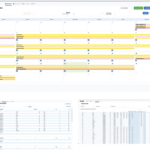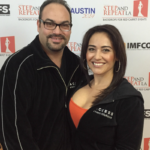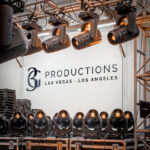Key to their future is their dedication to education and training. Since 1993 they’ve maintained a principled and formal dedication to safety, not only in regard to their products, but also for the industry. It was this year they started conducting classes and were one of the first ETCP-recognized rigging training programs. They have been and continue to be a key contributor with the PLASA (formerly ESTA) Technical Standards Program — as has recently-named president and general manager Mike Garl.
History
Mitch Clark founded Tomcat in April of 1987. There, in Midland, Tex., with a mere five employees in a building of less than 5,000 square feet, Clark and his team quickly developed a reputation of innovation and service. Soon they were working with the likes of Pink Floyd, Genesis and The Rolling Stones.
By the late 1990s, Tomcat moved into the manufacturing of portable outdoor roof systems. Early successes included EMP’s Sky Church at Seattle Center, the Rio Las Vegas Hotel & Casino and the Millennium Dome in London. Then it was on to Broadway as they provided equipment for touring Broadway shows including the Lion King, Mamma Mia, The Producers and Wicked.
Also before the dawn of the new century, Tomcat acquired U.K.-based Brilliant Stages and opened up Tomcat de Mexico in Guadalajara to handle increased manufacturing needs.
The 2000s marked the start of a period of innovation as the industry welcomed such products as Swing Wing folding truss for transporting pre-rigged lighting fixtures, standard dance towers and Baxx Truss self-stacking folding truss for arenas. The company also improved and updated fabrication techniques and qualifications and continued to expand globally. In 2005, the company started developing a relationship with Cirque du Soleil when they were called in to work on the show Ka, which the Los Angeles Times called “the most lavish production in the history of Western Theater.”
In 2007, although U.K.-based Vitec Group purchased Tomcat from Clark for $22.8 million, the company’s identity and small, family-owned feel were preserved, but this small company now had all the resources that a multinational global conglomerate can provide. Popular Tomcat products were updated and improved, and the company continues to be asked to work with touring acts as well as high-profile clients like the Guggenheim Museum and Baylor University.
A Unique Perspective
Don Dimitroff was with CM Hoist for 13 years before joining Tomcat in 2009. Today he’s director of sales and marketing.
Tomcat was an important customer of CM’s, and, accordingly, Dimitroff arrived with a unique perspective of the organization. “Honestly, my move here was largely based on the people. There’s just this energy and determination to make sure everything is done right and the customer is taken care of.” When he arrived, he noticed that the enthusiasm permeated through the company from the ground up.
Keith Bohn, now custom projects director, joined Tomcat “as a lowly sales guy” 15 years ago, when Tomcat “was not as broad and global as it is today,” he says. One of his surprises was the friendly size of the company. “There’s this perception that Tomcat must be big thing with thousands of square feet of warehouse, hundreds of workers — but, in fact, it’s a relatively humble factory. And despite our growth in terms of services, products and projects, it’s basically the same amount of people here today as there were when I got here.”
There have been many impressive projects through the years, but Bohn recalls a 100-foot wall done for a GM auto show. “It was Frank Gehry-like, an inspired piece of work that was twisted, pushed and pulled, but it was made of steel and needed to stand with just two support points.” And they couldn’t just focus on setting it up on the show floor — they had to construct it in such a manner that the unusual pieces could be built no more than 102-inch wide so as to fit onto the truck, be road worthy to make the trip from Midland to Detroit, get in through the challenging older convention hall and fit together there in such a manner that it met the client’s demanding needs. “It was a very methodical and detailed process.”
Product support manager Will Todd has been with Tomcat USA since 2000, previously working with the company as a head electrician for Disney on Ice. He credits their success in part to their in-house design people. “We’re currently using AutoCAD 2012 — we pride ourselves using the most up-to-date software to be better-equipped to supply clients with the best solutions.”
Training
Tomcat will be celebrating their 25th anniversary throughout the year, marking the milestone with training programs as well. Typically, their four- and five-day programs can bring in 60 to 80 people from all over the country for a week. “When I was with [Columbus McKinnon], going to different company’s training sessions was a fun part of my job, but when you got to Tomcat school, it was always different,” Dimitroff says. “It was always bigger, bolder and more current, and that’s certainly true today. At XYZ company, you’d show up at some cold and dirty garage. But at Tomcat, there’s a receptionist at the airport and a gift basket in the hotel room. The training took place in a comfortable hotel ballroom.”
He says the focus of the company has always been on education. “Our business is underserved when it comes to training, and we always want to give people another outlet to learn.” To emphasize this, he points out that while rigging and trussing is perhaps less sexy than light or audio training, if a light bulb burns out or a speaker goes out you can replace it, “but if you’re in trouble with rigging, the consequences are a whole lot greater.”
Bohn is a principal voting member of the PLASA Rigging Working Group and has been involved in the writing of ANSI standard for the entertainment industry since 1998. He chairs the task group for ANSI E1.21, outdoor structures for entertainment. Todd too is a member of the PLASA Rigging Working Group and has been involved in the writing of ANSI standards for the entertainment industry. He’s conducted training sessions on truss and ground support usage as part of Tomcat’s Hoist and Rigging School and LDInstitute.
“It’s something we take a lot of pride in — sitting on panels, giving our input into standards, improving the industry’s practices,” Todd says. “Every year for nearly 20 years, we’ve been doing some sort of hoist and rigging workshop.” Truss training is a part of all training, but from there the professional can focus on hoists or rigging. “We give the instructor more time in these situations to go into depth, so students really get the most of their training. Also, we pride ourselves on our technology and our shop, and we want to show it all off as much as we can.”
A Vitec Future
“We want to expand ground support and roof training in ways that haven’t really been done in a public way yet,” says Dimitroff. “This year we’re going to take the training up a notch, and how we approach this will be one of our innovations going forward.”
Vitec is a big component, especially since Stefano Rosellini has been the managing director of Tomcat since 2009. “Having decided to broaden my experience, I was looking for a company that was ethical, had a strong brand and was well-respected in the marketplace,” Rosellini says. “I was very much intrigued by Tomcat and its people, where I found a strong and diverse team of individuals that I could work with, a brand that had recognition in the entertainment and live events industry, and, more importantly, a willingness to grow and move the company to the next level.”
He says there was an aggressive expansion plan in place, which attracted him to the opportunity. “The market in which we operate is becoming more and more global. Our industry has matured in the last 10 years and the latest recession has accelerated industry consolidation and changed the way many of our customers operate. We also see a generational change. This presents many challenges in terms of know-how that is leaving the industry, but at the same time it presents a number of opportunities for companies that are constantly scouting the industry to find the right talent to expand our team. We work at a company that offers a positive and fun environment in which people are enthusiastic to work for.”
“There has been a vast evolution, amazing growth and expansion since we’ve become part of Vitec,” Bohn says. “But the energy, the desire to achieve the near impossible, to challenge the laws of physics and meet challenging schedules, has remained the same.”
“Being part of Vitec has really opened us up,” Todd agrees. “As a private family-owned business, it was harder to gather capital. The next several years are going to be really exciting as we start moving in new directions.” This might include flying performing and developing more staging products. “We have the talent in house, so it’s a thrilling time for us.”
Bohn adds that the reality of today’s marketplace is that truss is a “simple” commodity. “It’s not a piece of technology, like the iPhone, something where you have to get the new version every six months. If you take care of it, it lasts a long time, and because of that, people take it for granted. Some take what goes into creating it for granted. It’s not rocket science; it’s cutting pieces of aluminum and welding it. But here there’s a lot documentation, certifications and safety checks. Some of these newer truss companies don’t even put serial numbers on their products! How does that promote safety and integrity in our industry? Most customers are savvy, but some overlook that and are tempted by a slick ad, thinking it means quality.”
A key to Tomcat’s longevity is its consistency. “That and the can-do energy,” Bohn continues. “We’ve always had this aggressive can-do approach. Also, we don’t just supply what a client wants, but can dig a little deeper to see what they need. We’ll get a ‘grocery list,’ and for many, that’s exactly right and we provide it. Other times, we’ll go back and ask questions and figure out better ways to accomplish their goals.”
Dimitroff stresses that the company is more than just a catalog of trusses, but one that has depth of services and products. “Nobody has the same history or depth across the market as Tomcat,” he says. “Whether it’s a GM booth at an auto show or the Cirque’s touring Michael Jackson show, you can’t beat Tomcat.”


